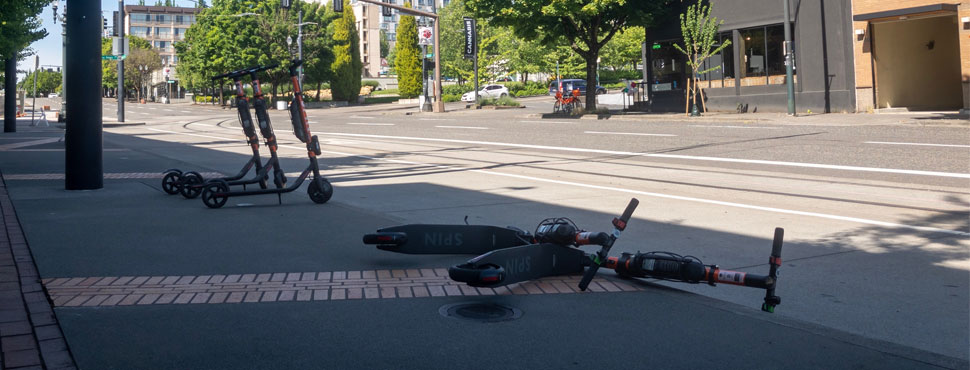Uncovering JAPA
Lessons in Managing Public Opinion During E-Scooter Pilot Program in Eugene, Oregon

How do public sentiments evolve during a pilot project? Planners are tasked with interpreting opposition and fact-checking controversy for public officials, enabling them to decide whether to cancel or expand a test program.
In "Pilots and Shifting Public Sentiment: Evidence from E-Scooters in Eugene (OR)" (Journal of the American Planning Association, Vol. 91, No. 3) Anne Brown, Calvin Thigpen, Nicholas J. Klein, and Kelcie Ralph present a longitudinal study that examines how both direct and observational experiences with an e-scooter pilot program influence individuals' support for new initiatives. The study explores how planners navigate the shifting tides of public opinion.
The authors argue that planners can adopt strategies to support both the public and political leaders in navigating skepticism toward pilot programs. These strategies include building trust to create space for change, systematically collecting public feedback, and providing clear channels of communication.
Pilots Over Time
The authors examined a single controversial project over time, surveying the public in three waves — before, during, and after a shared e-scooter pilot program in Eugene, Oregon. By analyzing changes across the survey waves, the study distinguished between anticipated outcomes and views that emerged during the program's implementation.
The study also included interviews with five local practitioners conducted before and during the pilot, exploring how they listened to and interpreted shifting public opinions. The authors noted that practitioners anticipated that initial pre-pilot skepticism would soon subside.
One practitioner expected the pilot project to ease public discontent: "I feel like once people see it in operation, they'll be like, 'Oh, it's not that big a deal,' or 'Oh, it's even great.' I think that the public perception will shift toward more positivity in general."
Why study e-scooters?
Shared e-scooters are a new form of transportation infrastructure, representing both the unknown and a departure from the status quo of cars, bicycles, and walking. Public views are strong but remain in flux. The authors argue that their findings have broader resonance, extending beyond micromobility, and can inform other pilot programs.
Public opinion surged during the launch of the pilot. Residents sent emails to city staff, left voicemails with the vendor and the operator's customer service lines, and, according to one practitioner, "One person … had taken it upon themselves to collect a bunch of comments on various Facebook pages and Nextdoor feeds … and submitted that."
Practitioners helped the city council weigh complaints filed immediately after the program's launch. They reminded the council, "This is a pilot, and these are issues that we knew we would have, and here's how we're addressing them."
Staff worked strategically to address safety concerns related to e-scooters, including those raised by one elected official who was, according to a practitioner, "Very caught up on the number of ER visits that increased … in some communities."
Staff recognized that these worst-case scenarios were unlikely to represent the majority of experiences. Nevertheless, they deliberately listened and took steps to address public concerns by requiring first-time users to travel at reduced speeds and complete a quiz before their first ride. Sidewalk riding was prohibited, and riders were required to wear helmets.
At the same time, practitioners worked to correct common misconceptions about the pilot program. Thirty percent of public complaints concerned tax dollars funding the program; however, no public funds were used to operate the e-scooters. Staff responded to each comment directly.
City staff made efforts to survey the broader community about the perceived benefits and drawbacks of the e-scooter pilot program. Findings revealed overall levels of support from both riders and nonriders, in contrast to the largely negative, but more limited, comments received through public forums.
Past and Future E-scooter Pilots
Previous research has shown that actually riding e-scooters is closely linked to sentiments about the mode. The Eugene pilot echoed these findings. Although the experience was almost universally favorable for repeat riders, it was decidedly mixed for one-time riders. Nonriders also viewed scooters more positively after the pilot period, suggesting that pilots provide opportunities for observation, learning, and shifting opinions, even among those without direct experience.
Planners should not shy away from testing new ideas: initial skepticism can shift with experience and exposure. Well-run and well-received pilot programs can help overcome early public opposition to new policies or initiatives.
KEY TAKEAWAYS
- Conduct meaningful outreach to build trust and create space for change.
- Avoid relying on unsolicited public input; it will mostly be negative.
- Take steps to gauge the representativeness of public comments.
- Systematically survey the public to gauge overall support.
- Carefully correct common public misconceptions.
- Help public officials ride the wave of public opinion, including interpreting and responding to initial opposition.
Top image: Photo by iStock/Getty Images Plus/ egexplorer
ABOUT THE AUTHOR


